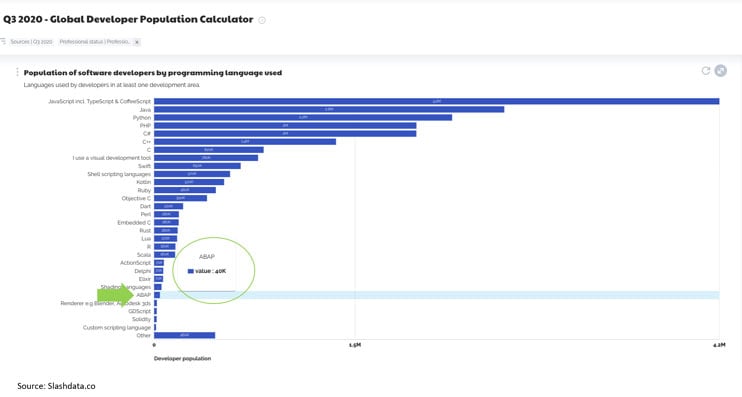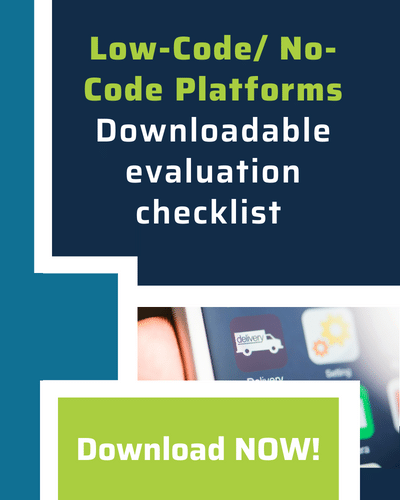SAP Rapid Application Development (RAD) minimizes the time and expense of creating the software applications your business needs. Although an SAP implementation can streamline and automate many workflows within an operation, customization and application development are usually necessary to support unique tasks and the specific ways a business operates. SAP rapid application development makes development faster and easier by providing teams with functional modules they can build into apps, saving time to deploy or change features.
However, businesses that are ready to give their IT teams – and their organization as a whole – the benefits of SAP rapid application development won’t take long to discover that these platforms can differ substantially in the capabilities and user experiences they provide. (Read about SAP App Development).
Use these 13 criteria to evaluate SAP rapid application development platforms to help you find the optimal solution for your business.
-
Visual model development
Finding skilled developers – particularly resources skilled in cloud development -- is a common challenge during the IT skills shortage. A low-code RAD platform with visual-based modeling reduces complexity, saves time, and helps your team, regardless of their cloud development experience, create applications that deliver the functionality and performance you need.
Using a visual model, developers drag and drop rather than write lines of code, which in turn is translated to code in the back end. This is also referred to as a low-code or no-code solution. In low-code solutions, developers can supplement that automatically written code and modify or add code lines wherein no-code the developer typically doesn’t have access to the code.
-
One-click deployment
After development is complete, the next step is to deploy the application across landscapes in tandem with the SAP environment, which is typically a time-consuming, manual process. Automating application deployment is possible on your own, but if you’re looking for faster implementation, this process will cause delays.
Find a platform that automates deployment, in tandem with your SAP transports across the landscape, preferably with a single click.
-
SAP roles and authorizations
When you are using an SAP-specific RAD, you want to make sure you can leverage all SAP roles and authorizations. Most RAD systems treat SAP as “just another source application” to get all the data, and as a result SAP BASIS admins have to maintain roles and authorizations in two places that can quickly go out of sync. Look for a rapid application platform that uses all of SAP roles and authorizations for easier maintenance.
-
Cloud-native - SAP Cloud Platform Rapid Application Development
Some RAD platforms claim to be cloud-native, but it’s important to recognize the difference between platforms that enable development in the cloud and those that are truly cloud-native, enabling users to take advantage of all of the cloud’s features, such as scalability and resilience, saving resources and costs and allowing for better performance. IBM research has found that cloud-native solutions improve development and roll-out time by an average of 73 percent and application management and scalability by about 75 percent. In addition, cloud-native RAD platforms improve application performance by 84 percent and reduce application downtime and associated costs by 79 percent.
-
Deploy on any form factor
For the greatest agility, choose a platform that allows you to develop and automatically adjust the user interface to display optimally on any device -- desktop, mobile or handheld embedded devices.
Look for a platform that allows you to create native applications for specific devices, such as Android tablets or iOS smartphones, and generate embedded applications for particular devices, such as rugged Zebra handhelds, without additional coding – just a few clicks.
-
Mobile-native integration
Beyond deploying on a device, it’s important that the platform also enables you to develop mobile-native applications (e.g., iOS, Android, Windows) that can take advantage of the device and its operating system’s functionalities, such as its camera, scanner, and geolocation features.
Several RAD platforms have this functionality; however, as you evaluate your options, consider the user experience the platform provides. Ask for a demonstration of how easily and quickly your team can achieve mobile-native integration.
-
Automated testing on any device in every environment
Regression testing is necessary when you add new features or make changes to applications to ensure it won’t impact existing functionality. In a multi-device, multi-service-provider environment, however, it can be challenging. Your app may work on an Android on the AT&T network but create bugs for Android using T-Mobile services.
Your RAD platform provider should give you the ability to script test cases and run them automatically on all devices and environments. This feature has been a particular advantage during the pandemic, allowing people to remain distanced when their devices are tested.
-
Direct access to data with no reliance on SAP connectors
The best-case scenario when using a RAD platform with SAP is to find one that gives you direct access to data with no reliance on SAP connectors or appliances: Pillir.
With deeper integration with SAP than any other low-code platform, Pillir communicates directly with the SAP system using a plug-in. Competitors use APIs to interact with SAP and require their users to build OData endpoints as well as advanced business application programming (ABAP) customizations to make those connections, which can be very labor-intensive.
Pillir doesn’t “talk” to SAP like other platforms; data flows from inside SAP through Pillir to the user.
-
Convert ABAP to mobile
Businesses transforming their operations by migrating to S/4HANA or preparing to move to the cloud can hit a roadblock with their current customizations as they often need to be recreated from scratch. In some cases, those ABAP applications are years old, and the current IT staff is unfamiliar with the code or the business logic implemented in that business process.
Another of Pillr’s unique features is its ability to convert existing ABAP into low-code objects that can be used in the cloud or on mobile so that they aren’t lost during a transition – and so developers don’t have to build them again from the ground up. The organization reduces technical debt and doesn’t lose the tribal knowledge and capabilities built over the years.
-
Offline
Virtually every RAD platform you evaluate will claim to support offline work, but you need to dig deeper. Some platforms may allow you to work offline for short periods and then sync with SAP, sometimes with human intervention, when the connection is restored.
However, some businesses require robust offline capabilities, such as field technicians in oil and gas or offshore drilling or mining teams who may be offline for extended periods. A smarter investment is technology that delivers the same user experiences, such as creating work order numbers and locating components or replacement parts, offline or online. allowing its users to complete complex business processes when offline for days or shifts. It’s also vital that the platform orchestrates data synchronization without sacrificing security.
-
Extensibility
Some no-code RAD platforms give you a set of tools and sometimes a proprietary development language but provide you with no ability to extend their capabilities.
On the other hand, low-code platforms allow you to extend functionality and build reusable activities, such as API connectors you can reuse for future integrations, as well as base programming, logical steps, and front-end elements. You probably should consider, limiting your search to a platform that uses JavaScript, the most widely used language today with the most availability of developers around the world, or another open-source programming language.

(Source: https://www.slashdata.co/)
-
Pre-built library of best business processes
SAP users should find a rapid application development platform designed specifically to work with SAP and provide you with a library of application templates that minimizes development time. Pre-built connectors to different SAP elements such as HANA, IDocs, etc., as well as templates that provide best-practice for common business processes provide a base that simplifies the creation of new processes further and ensures that the business processes are optimized.
-
Pure SaaS consumption with no infrastructure overhead
RAD platform pricing structures can also vary, even though they are delivered via the Software as a Service (SaaS) model. Do your due diligence to understand pricing and make a one-to-one comparison.
The optimal pricing structure for a RAD platform for your business is a pure consumption model in which you only pay when your team logs on and uses the platform. Some solutions in the market will charge customers for seats even if no one uses the platform that month, and some charge an additional infrastructure fee. Ensure you have a clear picture of pricing before choosing a platform so there won’t be surprises later.
The Advantages of the Right SAP Rapid Application Development Platform
When you find the best SAP rapid application development platform for your business, you gain the ability to enhance mission-critical workflows with new functionality – and decrease the pain associated with development. Your team will deploy applications faster, contribute to greater efficiency and productivity, improve customer experiences, and create a more competitive operation.
To see Pillir’s low-code SAP Rapid Application Development in action, schedule your demo.



 Back
Back/Logo%20-%20black%20text%20blue%20pillar%20(large)-1.jpg)

